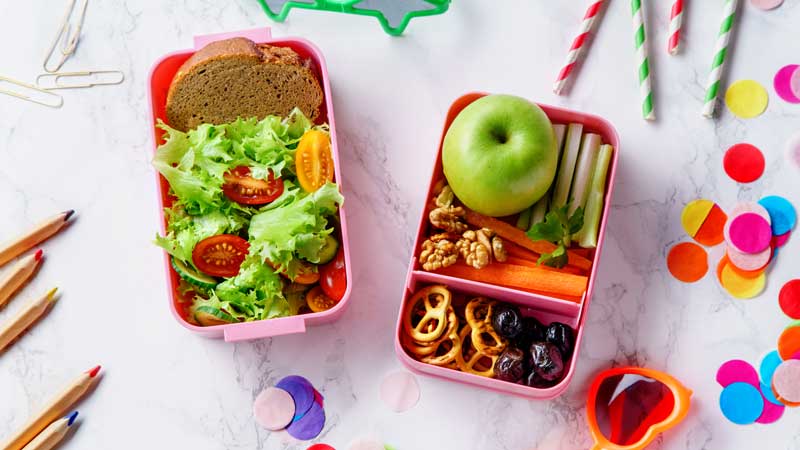Prepping school lunch boxes can be the bane of one’s existence. In Australia there’s about 200 teaching days so that means 200 school lunches, and that’s only if you have one child! As a teacher I get to see many variations of lunch box contents everyday and I’m well aware of the judgement placed on parents by schools for lunch box decisions. We also need to consider that not all parents are in charge of packing a lunch box. There are circumstances where it’s completely left up to the child and other situations where parents try but the angst or anxiety in pleasing their child leaves the child with more authority over the decision making.
Recent research conducted in the UK with four primary schools investigated the factors that influenced parents in the packing of school lunches, food preparation choices and the role children had. The results of this small study does not have any surprises as to who the lunchbox gatekeepers were. The children. I’m by no means being hypocritical here nor do I make any kind of judgement because I recognise that this isn’t a black and white situation. First, I will briefly delve into the study then I’ll share some practical ways to address this in your home.
Summary of findings from the study, “That’s His Choice Not Mine!” Parents’ Perspectives on Providing a Packed Lunch for Their Children in Primary School.
- Children’s authority is growing in everyday food decisions.
- Parental anxiety may impact what’s packed in the lunch box due to the perception that food must be eaten.
- Children made specific requests when shopping.
- Children try to persuade parents to pack food that they reported other children brought to school.
- Further research needs to be undertaken to explore children’s perceptions of their role in food decisions.
- There are implications for schools in regards to food, nutrition education and interventions.
How can I make a positive impact on food selection for my child’s lunch box?
Parenting practices that support positive modelling of food behaviours, food choices and feeding strategies impact on your child’s food preferences. Providing regular family style meals with availability of a variety of foods where children can choose what and how much to eat allows children autonomy and independence. Removing the expectation of eating all foods presented leads to a more relaxed eating environment and in turn helps children regulate their own hunger and satiety. When this is overridden with pressure or coercion to eat, it devoids a child’s natural biological response resulting poor appetite control. Focusing on diet quality without excessive restriction is also associated with better food relationships and satisfaction with body image.
Tips for packing the school lunch box
- Pack leftovers from dinner the night before.
- Present food in novel ways. E.g. use cookie cutters, make pinwheel wraps or bliss balls
- Present familiar ‘safe’ foods that you know your child will eat.
- Provide a variety of foods from the five food groups.
- Allow children to help with the preparation and packing. E.g. Get your child to make a homemade dip or make their own sandwich or wrap.
- Ask children to pick different coloured fruits or vegetables or encourage three different coloured foods to be selected or have an ‘eat the rainbow’ lunch box guideline.
- Have batches of foods frozen that can easily be defrosted. E.g. bliss balls (nut free), muffins or tuna/veggie patties.
- Allow ‘sometimes’ foods to be chosen ‘sometimes’. (Remember complete restriction increases the ‘sometimes’ food appeal!)
How do I teach responsible decision making with the foods my child may preference?
This comes back to parenting and communication with your child. Treat the feeding experience just like a learning experience that is built on, at each and every meal. It’s just like learning how to read; you build the foundations (letters, sounds, words and sentences), model the behaviours and strategies then progressively learn to read more complex texts. This is the same for eating, build the foundations with family meals providing a range of quality foods alongside ‘sometimes’ foods. Allow your child’s preferences and tastes to grow over time.
Model, practise and support your child in learning how to make choices and decisions. Talk about values and develop an understanding that not all decisions will be the right or happiest decision. In the space of learning about food decision making, this may mean allowing your child the experience of overeating and it might be a time when ‘sometimes’ foods are more available. Afterwards have a brief discussion about how their body felt in that situation. Remaining neutral in these conversations can be challenging but this allows your child to tune in with their body.
Ultimately the gatekeeper can be a joint effort between you and your child. It’s just a matter of how you put the wheels in motion to support your child in teaching them how to nourish their body in the best possible way.
References
“Parents’ Perspectives on Providing a Packed Lunch for Their Children ….” http://www.jneb.org/article/S1499-4046(17)31044-8/fulltext. Accessed 16 Jun. 2018.
“School lunch decisions made by the child and not the parent.” 6 Apr. 2018, https://medicalxpress.com/news/2018-04-school-lunch-decisions-child-parent.html. Accessed 16 Jun. 2018.
“Nutrients | Free Full-Text | Factors Influencing Children’s Eating … – MDPI.” 31 May. 2018, http://www.mdpi.com/2072-6643/10/6/706/htm. Accessed 16 Jun. 2018.
“Five tips to help children develop decision-making skills | kidsmatter ….” https://www.kidsmatter.edu.au/families/enewsletter/five-tips-help-children-develop-decision-making-skills. Accessed 16 Jun. 2018.



Well written & non judgemental. As a parent l get anxiety over lunch box’s & now my child plays a role & happily eats all her lunch box now. The other day she packed only fruit, Veges & cheese slices 😜. Looks like lm heading in the right direction 🙏
Thank you Sandra. That was my intention – to remove judgement as it doesn’t help anyone. I’m glad that you are working with your daughter to build a happy and healthy relationship with food. Keep up the great work.